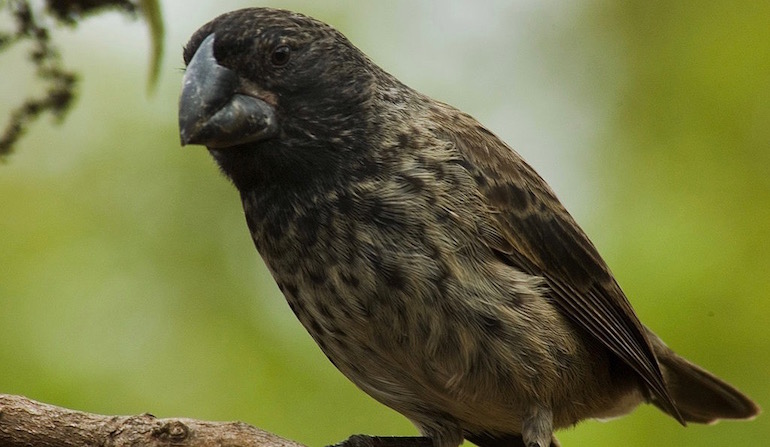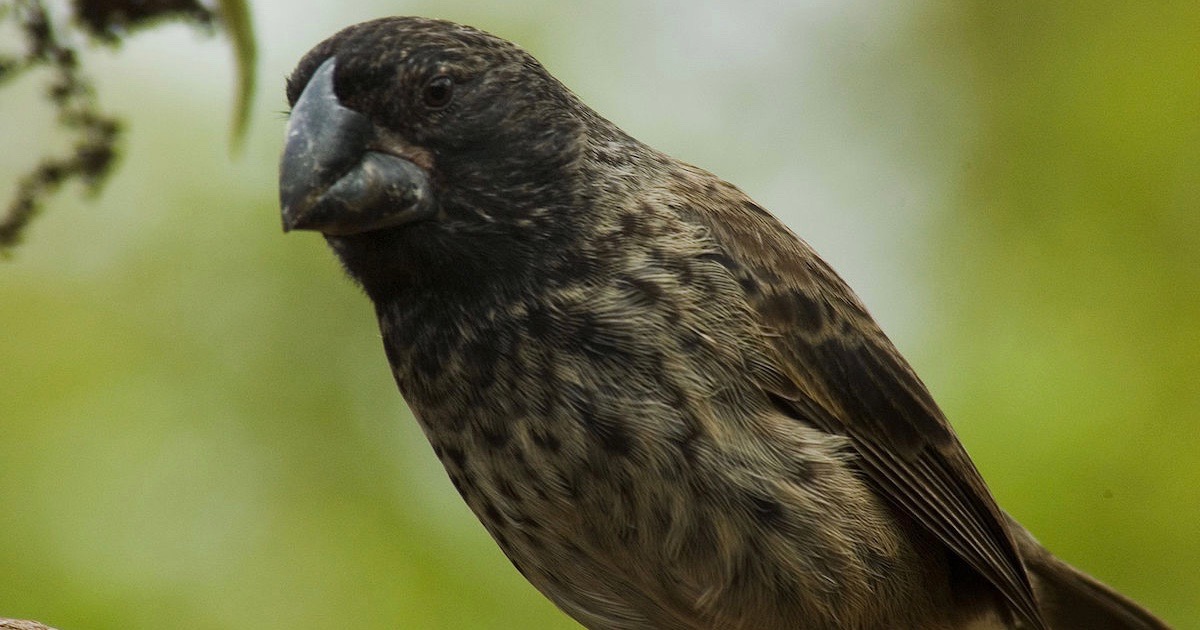 Evolution
Evolution
 Intelligent Design
Intelligent Design
Evolving Icons of Evolution

Peter and Rosemary Grant, the husband and wife pair from Princeton University, have spent 40 years studying four species of ground finch on one uninhabited island of the Galápagos archipelago. They are to be commended for their dedication, and for details that they have published over the years about the birds made famous by Darwin. (Design advocates appreciate the Grants for their findings that undermine neo-Darwinism, although they would not see it that way.)
In a new Perspective piece in Science Magazine, “Watching Speciation in Action,” they show that they are not the only ones who have witnessed the origin of species. Beginning with the Darwin quote about “grandeur in this view of life” that evolves, they describe a number of studies like theirs that illustrate organisms that have varied and diversified from parent stock. Let’s begin by listing the examples and what is known about them, both genetically and phenotypically. These can be considered their finest “icons of evolution” for 2017.
- Darwin’s finches. The Grants witnessed variations due to five beak genes, two transcription factor genes, hybridization, climate forcing, and reproductive isolation.
- Peppered moths. The black morph comes from one transposon, which “suggests that transposable elements may play a more important role in generating variation among species in ecologically important traits than is currently realized.”
- Pentstemons and morning glories. Asymmetric loss-of-function mutations and inversions tend to change pollinators from bees to hummingbirds, but not the reverse.
- Ruff, a wading bird “with an unusual mating system in which three male forms, differing in plumage and behavior, compete for females on a courting arena.” An inversion 3.8 million years ago, they say, was followed by mutations that produced this result.
- Deer mice in Nebraska’s sand hills. The lighter coat colors, adaptive for the sandy environment, “were the result of selection on not one but multiple mutations in the Agouti”
- Three-spined sticklebacks. Marine fish that have colonized freshwater environments repeatedly evolved into surface dwellers and bottom dwellers. They also lost the pelvic apparatus and armor through similar genetic pathways (involving a transcription factor and a signaling protein).
- High-altitude birds. Hemoglobin adaptation to high altitude has been shown to involve “repeated use of the same genetic pathway.” It “may be the case generally” that “closely related species use similar genes, whereas more distantly related species use different genetic pathways that depend on their genetic backgrounds.”
- Heliconius butterflies. The genes involved in Mullerian mimicry are shown to be due to introgressive hybridization, “that is, gene exchange between species as a result of hybrids backcrossing to a parental species.” This process is also seen in the Darwin finch study.
- Mosquitos and mice. Cases of insecticide resistance have been “transmitted between populations” by introgressive hybridization.
- Asian longhorn beetles. These eukaryotes, in a case “even more remarkable, and similar to introgressive hybridization,” obtained genes for digesting plant cell walls via horizontal gene transfer from bacteria and fungi.
- High-altitude humans. They say that Tibetans may have obtained adaptation to high altitude via interbreeding with Denisovans.
- Sunflowers. Members of Helianthus colonized salt marshes via “transgressive segregation,” a form of hybridization whereby individuals can “colonize novel habitats where neither parental lineage can survive.”
- Blind cave fish. Mexican fish lost vision via “release of hidden [cryptic] variation.” In their case, the heat shock protein HSP90 masks variation for eye size in surface waters. “This variation is exposed in the altered conductivity of cave water and becomes available for selection.”
It’s an impressive list. The Grants have thrown down the gauntlet to Darwin skeptics, providing a baker’s dozen of clear examples of variation leading to populations with phenotypic change. But before we bow before these icons, we should ask some important questions — like those Jonathan Wells asked in his classic book, Icons of Evolution (2000). What kind of evolution have they really shown? Nobody doubts variation. It was clearly evident long before Darwin. Even today, the most ardent creationists allow for significant variability within what they call “created kinds,” while a good number of intelligent design advocates cheerfully accept universal common descent even as they reject neo-Darwinian evolution as the explanation for it.
To distinguish Darwin’s explanation from these positions, therefore, the burden on the Grants is to demonstrate adaptive variation arising by random mutations and positive natural selection. (Loss of function, while interesting, is not particularly helpful to their argument.) These adaptive variations, moreover, must be significant enough to create true novelties, innovations beyond mere reshuffling of existing information. And they must persist in new populations that are reproductively isolated, so as to branch off Darwin’s tree in new directions. We need to see something as significant as the presumed first tetrapod colonizing land, or the first dinosaur obtaining powered flight — something on a new fitness peak that has the appearance of being designed, but is now demonstrably explainable by gradual steps up the backside of Mt. Improbable. Furthermore, the selected random variations should be detectable in the genes.
A key point of the Grants’ article is that variation did not always arise by random mutation. In fact, most of the cases in their list involve reshuffling of existing genetic information by interbreeding, hybridization or horizontal gene transfer. This immediately takes #8-12 off the list. The challenge to Darwinism by hybridization was shown in our post last year, “Hybrids Weave Darwin’s Tree into a Web,” which mentions the Grants and the potentially devastating impacts of this “revolution” on their work.
Loss of function takes #13 off the list as well as #2, #3, and #6. None of these demonstrate Darwinian evolution. That leaves us with #1 Darwin’s finches, #4 Ruff, #5 Deer mice, and #7 High-altitude birds. To give the best benefit of the doubt, we might put #11 High-altitude humans back on the list with #7, High-altitude birds.
Jonathan Wells discussed three of these icons in his book: #1 Darwin’s finches, #2 Peppered moths (see his update last year), and #11 Human evolution. The Grants don’t offer any new solutions. In fact, the situation is worse now for Darwinians than it was in 2000. Now we know that hybridization was involved in the finches. Now we know that a transposon created the dark peppered moth — a case of shuffling of existing information. And now we know about interbreeding of modern humans with Neanderthals and Denisovans, proving they were compatible species and not “reproductively isolated” (a requirement for speciation). None of the variations in these cases are demonstrably due to neo-Darwinian mechanisms.
What about the Ruff wading birds? At best, these involve minor changes to existing information. Birds already were divided into males and females. Birds already had plumage. Birds already had behaviors. If all three male types can mate with the females, they are members of one species anyway; this is not a case of the origin of species.
What about the deer mice? This is another peppered-moth case, merely shifting the ratios of existing populations. Again, even if multiple mutations occurred in the Agouti locus, they only affected fur color. The mice already had fur. Lots of mammals, including humans, show wide variations in hair color. The paper in Science referenced by the Grants indicates that the coloration patterns fall on a continuum. The researchers used a highly-contrived artificial lab experiment to try to correlate fur color to predation, but even so, all the mice of all colors are members of the same species anyway. So, peppered mice? Much ado about nothing. See also what Casey Luskin wrote about stickleback fish (#6), and what Kirk Durston wrote about microevolution, which is what all the examples on the Grants’ list amount to.
In short, nothing the Grants presented rises to the level of evidence required to distinguish their view from those of intelligent design or even Young Earth Creationism. What’s perhaps most illuminating about the Grants’ article is the frank admission that, 158 years after Darwin’s Origin, and after 40 years on Daphne Major studying finches, evolutionists still do not understand microevolution, let alone macroevolution. In the first paragraph, they state:
Today, scientists are using genetics to understand how species multiply, and ecological and behavioral knowledge to understand why they do so [implying that they still do not understand]. However, many questions remain about the sources of genetic variation and how new phenotypes arise in response to environmental change [isn’t that what Darwin solved?]. Recent research has revealed unexpected origins of genetic variation, providing crucial insights into phenotypic divergence and the evolutionary effects of rare events triggered by global climatic change. [Emphasis added.]
Yes, be sure to mention climate change to score extra points with the editor. At the end, they state:
Future genomic and ecological research on natural populations will provide a more comprehensive answer to Darwin’s question of why the world is so extraordinarily rich in numbers, diversity, and complexity of organisms. Foremost among current questions is how gradual climate change and extreme climatic events cause rapid evolutionary change, and why some species groups diversify prolifically while others do not.
So exactly how much is understood about this theory that rules biology?
Photo: Large ground finch, by Peter Wilton [CC BY 2.0], via Wikimedia Commons.

